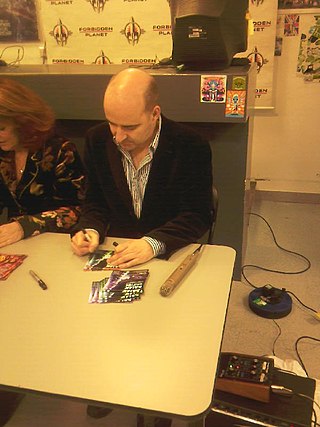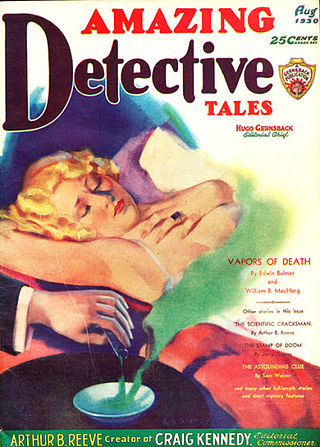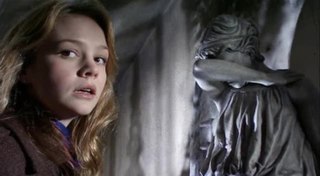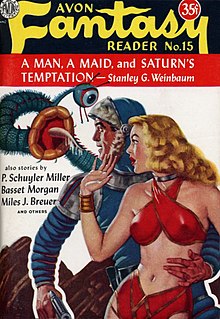
Doctor Who is a British science fiction television series broadcast by the BBC since 1963. The series, created by Sydney Newman, C. E. Webber and Donald Wilson, depicts the adventures of an extraterrestrial being called the Doctor, part of a humanoid species called Time Lords. The Doctor travels in the universe and in time using a time travelling spaceship called the TARDIS, which externally appears as a British police box. While travelling, the Doctor works to save lives and liberate oppressed peoples by combating foes. The Doctor often travels with companions.

The Daleks are a fictional extraterrestrial race of extremely xenophobic mutants principally portrayed in the British science fiction television programme Doctor Who. They were conceived by writer Terry Nation and first appeared in the 1963 Doctor Who serial The Daleks, in casings designed by Raymond Cusick.

Terence Joseph Nation was a Welsh screenwriter and novelist. Especially known for his work in British television science fiction, he created the Daleks and Davros for Doctor Who, as well as the series Survivors and Blake's 7.

The Daleks is the second serial in the British science fiction television series Doctor Who, which was first broadcast on BBC TV in seven weekly parts from 21 December 1963 to 1 February 1964. Written by Terry Nation and directed by Christopher Barry and Richard Martin, this story marks the first appearance of the show's most popular villains, the Daleks, and the recurring Skaro people, the Thals. In the serial, the First Doctor, his granddaughter Susan Foreman, and her teachers Ian Chesterton and Barbara Wright land in an alien jungle and are captured by the Daleks, a race of mutated creatures who survive off the radiation that remains in the atmosphere after a nuclear war with their enemies. As the group attempt to escape the Daleks, they discover more about the planet and the ensuing war, and attempt to broker a peace.

Since their first appearance in 1963 there have been a number of variant models of the Daleks, a fictional alien race in the BBC science fiction television programme Doctor Who.

Little green men is the stereotypical portrayal of extraterrestrials as little humanoid creatures with green skin and sometimes with antennae on their heads. The term is also sometimes used to describe gremlins, mythical creatures known for causing problems in airplanes and mechanical devices.
"Dalek" is the sixth episode of the revived first series of the British science fiction television programme Doctor Who. It was first broadcast on BBC One on 30 April 2005. This episode is the first appearance of the Daleks in the 21st-century revival of Doctor Who; it also marks the first appearance of Bruno Langley as companion Adam Mitchell.
Planet of Evil is the second serial of the 13th season of the British science fiction television series Doctor Who. It was first broadcast in four weekly parts on BBC1 from 27 September to 18 October 1975.

The Chase is the eighth serial of the second season in the British science fiction television series Doctor Who. Written by Terry Nation and directed by Richard Martin, the serial was broadcast on BBC in six weekly parts from 22 May to 26 June 1965. Set in multiple time periods on several different planets, including Aridius, Earth, and Mechanus, the serial features the Dalek race travelling through time while pursuing the TARDIS and its occupants—the First Doctor and his companions Ian Chesterton, Barbara Wright, and Vicki —to kill them and seize the TARDIS for themselves. The Doctor and companions encounter several characters, including monsters Dracula and Frankenstein's monster, human astronaut Steven Taylor, and an android replica of the Doctor.

Nicholas Briggs is an English actor, writer, director, sound designer and composer. He is associated with the BBC science fiction television series Doctor Who and its spin-offs, particularly as the voice of the Daleks and the Cybermen in the 21st century series.
The Ambassadors of Death is the third serial of the seventh season of the British science fiction television series Doctor Who, which was first broadcast in seven weekly parts on BBC1 from 21 March to 2 May 1970. The serial's script was credited to David Whitaker but completed primarily by Malcolm Hulke and Trevor Ray. It was directed by Michael Ferguson.

Earle K. Bergey was an American artist and illustrator who painted cover art for thousands of pulp fiction magazines and paperback books. One of the most prolific pulp fiction artists of the 20th century, Bergey is recognized for creating, at the height of his career in 1948, the iconic cover of Anita Loos's Gentlemen Prefer Blondes (1925) for Popular Library.

In science fiction and fantasy literatures, the term insectoid ("insect-like") denotes any fantastical fictional creature sharing physical or other traits with ordinary insects. Most frequently, insect-like or spider-like extraterrestrial life forms is meant; in such cases convergent evolution may presumably be responsible for the existence of such creatures. Occasionally, an earth-bound setting — such as in the film The Fly (1958), in which a scientist is accidentally transformed into a grotesque human–fly hybrid, or Kafka's famous novella The Metamorphosis (1915), which does not bother to explain how a man becomes an enormous insect — is the venue.

The Nightmare of Black Island is a BBC Books original novel written by Mike Tucker and based on the long-running science fiction television series Doctor Who. It was published on 21 September 2006, alongside The Art of Destruction and The Price of Paradise. It features the Tenth Doctor and Rose.
British television science fiction refers to programmes in the genre that have been produced by both the BBC and Britain's largest commercial channel and ITV. BBC's Doctor Who is listed in the Guinness World Records as the longest-running science fiction television show in the world and has even been labelled the "most successful" science fiction series of all time.

"Blink" is the tenth episode of the third series of the British science fiction television series Doctor Who. It was first broadcast on 9 June 2007 on BBC One. The episode was directed by Hettie MacDonald and written by Steven Moffat. The episode is based on a previous short story written by Moffat for the 2006 Doctor Who Annual, entitled "'What I Did on My Christmas Holidays' By Sally Sparrow".

The Weeping Angels are a race of predatory creatures from the long-running science fiction series Doctor Who. They were introduced in the 2007 episode "Blink", making repeat appearances in later episodes. They also appeared in the spin-off series Class. Since their initial appearance, they have been persistently nominated as one of the most popular and frightening Doctor Who monsters. Steven Moffat attributes their appeal to childhood games such as Grandmother's Footsteps and the notion that every statue might secretly be a disguised Weeping Angel.

The first season of British science fiction television programme Doctor Who was originally broadcast on BBC TV between 1963 and 1964. The series began on 23 November 1963 with An Unearthly Child and ended with The Reign of Terror on 12 September 1964. The show was created by BBC Television head of drama Sydney Newman to fill the Saturday evening timeslot and appeal to both the younger and older audiences of the neighbouring programmes. Formatting of the programme was handled by Newman, head of serials Donald Wilson, writer C. E. Webber, and producer Rex Tucker. Production was overseen by the BBC's first female producer Verity Lambert and story editor David Whitaker, both of whom handled the scripts and stories.














